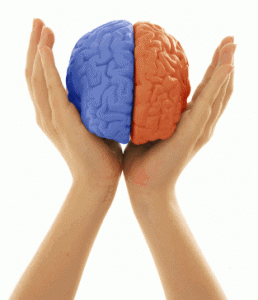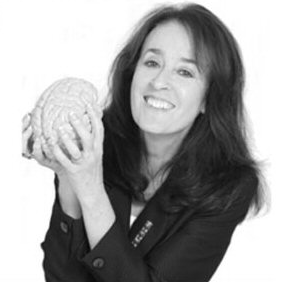__ 
Using the Whole Brain in
Leadership and Education
Each one of us has a personal thinking style which seems to be the way our brain naturally prefers to think. Actually this is because our brain consists of two sides and from birth one side is physiologically more dominant than the other. Those of us who are left brain dominant are more comfortable thinking in a logical, rational, detailed and ordered way. Right brain dominant people prefer to think emotionally, creatively and intuitively. When we use our preference for thinking with one side of the brain more often than with the other, we will be missing information from the side we are not using. This creates shortcomings in our actions and decisions. In fact we will be making half-brained decisions and behaving in half-brained ways!
The Challenge for Educators
There is enormous pressure on students of all ages to obtain high grades and to excel in academic achievement. The research conducted by Sandy Gluckman for her PhD, as well as vast research by esteemed people in the field of education, reveals that educators tend to emphasize left brain logical, linear thinking more than right brain creative, lateral thinking. Curricula are developed with the purpose of strengthening academic abilities (left brain), usually without integrating equal learning opportunities to strengthen self worth and self-esteem (right brain).
Some educational institutions do formally aspire to provide a curriculum that offers the education of both sides of the brain. Most do not. The danger is that the student’s creativity, self-esteem and feelings of self worth, do not develop as much as their intellect does.
The world is undergoing massive change. Academic degrees alone will not be enough for students to courageously and creatively deal with an increasingly challenging personal and professional world. They will need a powerful sense of self worth to propel them through this exciting and challenging new world.
The Challenge for Leaders
One of the characteristics of great organizational leaders is that they are well-read and informed about the fact that our brains like to think differently. They understand that as leaders they need the ability to ‘speak the language’ that the employees relate to. What this means is that some employees prefer to communicate with the logical left brain and others prefer the creative, emotive communication of the right brain. Speak to a ‘left brainer’ in an emotive, intuitive way and guess what? They don’t get the message! Speak to a ‘right brainer’ in a logical, ordered way … and they don’t get it! That is why great leaders learn to communicate with the whole brain so that they can engage all employees and inspire them to deliver exceptional productivity.
Great leaders also know that profitable and innovative decisions are made when there is open and honest dialogue during the decision-making process. These leaders invite creative and often heated debate by ensuring that their teams are made up of left and right brain thinkers. The result is a panoramic view on all challenges which leads to innovative and profitable decisions.
Leaders who value diversity of opinions make a conscious effort to hire people who do not think like they do. They hire people who think differently and who have the courage and spirit to speak out at meetings and share ideas that lead to creative and effective solutions.
Half Brained Teams Deliver Half Brained Results
Do you have a team of ‘clones’ who all think in the same way about most things? Or do you have a team that views the world from div erse perspectives and use these diverse perspectives to make powerful decisions that will benefit the team, as well as the organization?
erse perspectives and use these diverse perspectives to make powerful decisions that will benefit the team, as well as the organization?
Complete a Brain Dominance Profile and become aware of the thinking style of the team. This will alert you to what your team will think about and what they will leave out in planning and decision-making.
Click here to learn more about her Education Keynotes

